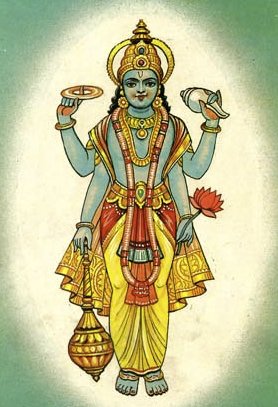Raktakshi, Raktākṣin, Raktākṣī, Raktakshin, Rakta-akshin: 9 definitions
Introduction:
Raktakshi means something in Hinduism, Sanskrit, Tamil. If you want to know the exact meaning, history, etymology or English translation of this term then check out the descriptions on this page. Add your comment or reference to a book if you want to contribute to this summary article.
The Sanskrit terms Raktākṣin and Raktākṣī can be transliterated into English as Raktaksin or Raktakshin or Raktaksi or Raktakshi, using the IAST transliteration scheme (?).
In Hinduism
Jyotisha (astronomy and astrology)
Source: The effect of Samvatsaras: SatvargasRaktākṣin (रक्ताक्षिन्) refers to the fifty-eighth saṃvatsara (“jovian year)” in Vedic astrology.—The man who is born in the ‘samvatsara’ of ‘raktakshin’ remains engaged in righteous (moral) and religious conduct, is extremely lustful, does not tolerate the growth of others and is always diseased or ill.
According with Jataka Parijata, the person born in the year raktakshin (2044-2045 AD) will be of a tranquil mind, fond of relatives, exceedingly fortunate and amiable.

Jyotisha (ज्योतिष, jyotiṣa or jyotish) refers to ‘astronomy’ or “Vedic astrology” and represents the fifth of the six Vedangas (additional sciences to be studied along with the Vedas). Jyotisha concerns itself with the study and prediction of the movements of celestial bodies, in order to calculate the auspicious time for rituals and ceremonies.
Vaishnavism (Vaishava dharma)
Source: Pure Bhakti: Arcana-dipika - 3rd EditionRaktākṣi (रक्ताक्षि) is the fifty-eighth of sixty years (saṃvatsara) in the Vedic lunar calendar according to the Arcana-dīpikā by Vāmana Mahārāja (cf. Appendix).—Accordingl, There are sixty different names for each year in the Vedic lunar calendar, which begins on the new moon day (Amāvasyā) after the appearance day of Śrī Caitanya Mahāprabhu (Gaura-pūrṇimā), in February or March. The Vedic year [viz., Raktākṣi], therefore, does not correspond exactly with the Christian solar calendar year.

Vaishnava (वैष्णव, vaiṣṇava) or vaishnavism (vaiṣṇavism) represents a tradition of Hinduism worshipping Vishnu as the supreme Lord. Similar to the Shaktism and Shaivism traditions, Vaishnavism also developed as an individual movement, famous for its exposition of the dashavatara (‘ten avatars of Vishnu’).
Shaivism (Shaiva philosophy)
Source: SOAS University of London: Protective Rites in the Netra TantraRaktākṣī (रक्ताक्षी) refers to “one who is red-eyed”, according to the Svacchanda-tantra.—Accordingly, [verse 4.21-27, while describing inauspicious dreams]—“[The dreamer] sees a bear or monkey, demons, cruel beings, and dark men. [He sees those who] have erect hair, dirty ones, those who wear black garlands, clothes, and coverings. That man who, in his dream, embraces a red-eyed woman (raktākṣī—raktākṣī strī ca yaṃ), he dies, there is no doubt, if he does not bring about peace. [...]”

Shaiva (शैव, śaiva) or Shaivism (śaivism) represents a tradition of Hinduism worshiping Shiva as the supreme being. Closely related to Shaktism, Shaiva literature includes a range of scriptures, including Tantras, while the root of this tradition may be traced back to the ancient Vedas.
Languages of India and abroad
Sanskrit dictionary
Source: Cologne Digital Sanskrit Dictionaries: Monier-Williams Sanskrit-English Dictionary1) Raktākṣī (रक्ताक्षी):—[from raktākṣa > rakta > raj] f. Name of a Yoginī, [Hemādri’s Caturvarga-cintāmaṇi]
2) Raktākṣi (रक्ताक्षि):—[from rakta > raj] m., [Catalogue(s)]
Source: Cologne Digital Sanskrit Dictionaries: Monier-Williams Sanskrit-English DictionaryRaktākṣin (रक्ताक्षिन्):—[from rakta > raj] m., [Catalogue(s)]
[Sanskrit to German]
Sanskrit, also spelled संस्कृतम् (saṃskṛtam), is an ancient language of India commonly seen as the grandmother of the Indo-European language family (even English!). Closely allied with Prakrit and Pali, Sanskrit is more exhaustive in both grammar and terms and has the most extensive collection of literature in the world, greatly surpassing its sister-languages Greek and Latin.
Kannada-English dictionary
Source: Alar: Kannada-English corpusRaktākṣi (ರಕ್ತಾಕ್ಷಿ):—
1) [noun] the reddened eye.
2) [noun] a male buffalo.
3) [noun] the fifty eighth year in the Hindu cycle of sixty years.
Kannada is a Dravidian language (as opposed to the Indo-European language family) mainly spoken in the southwestern region of India.
Tamil dictionary
Source: DDSA: University of Madras: Tamil LexiconRaktākṣi (ரக்தாக்ஷி) noun < raktākṣa.
1. The 58th year of the Jupiter cycle. See இரத்தாட்சி. [irathadsi.]
2. Four o'clock plant. See அந்திமந்தாரை. [anthimantharai.]
Tamil is an ancient language of India from the Dravidian family spoken by roughly 250 million people mainly in southern India and Sri Lanka.
See also (Relevant definitions)
Partial matches: Akshi, Rakta.
Ends with: Araktakshi, Ghoraraktakshi.
Full-text: Samvatsara, Siripura, Raghunathapura.
Relevant text
Search found 4 books and stories containing Raktakshi, Raktākṣin, Raktākṣī, Rakta-akṣī, Raktākṣi, Rakta-akṣin, Raktaksi, Raktaksin, Raktakshin, Rakta-akshin, Rakta-aksin, Rakta-aksi, Rakta-akṣī, Rakthakshi, Ragthaagshi, Ragdagshi, Ragdhagshi, Ragthagshi; (plurals include: Raktakshis, Raktākṣins, Raktākṣīs, akṣīs, Raktākṣis, akṣins, Raktaksis, Raktaksins, Raktakshins, akshins, aksins, aksis, Rakthakshis, Ragthaagshis, Ragdagshis, Ragdhagshis, Ragthagshis). You can also click to the full overview containing English textual excerpts. Below are direct links for the most relevant articles:
The Agni Purana (by N. Gangadharan)
Chapter 52 - Characteristics of images of different forms of goddesses
The Skanda Purana (by G. V. Tagare)
Chapter 45 - The Arrival of Sixty-four Yoginīs < [Section 1 - Pūrvārdha]
Modern Kannada Literature < [Jan-Feb 1940]
Preceptors of Advaita (by T. M. P. Mahadevan)